MORE PYRENEES GEMS
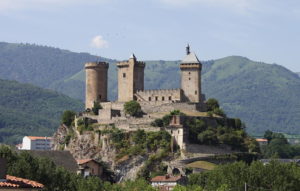
For a region that is relatively unexplored by many visitors to France, the Pyrenees has so much to offer. Not just its breathtaking scenery of snow-capped mountains, deep gorges and high altitude agriculture, but also for the number of beautiful little villages that have their own distinct architectural style and character.
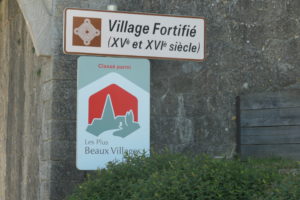
Many of the most charming villages in this south-eastern region of the Pyrenees are also categorised as part of the Plus Beaux Villages de France network. Some are tiny hamlets, while other sites have ancient abbeys nestling in the folds of the hills.
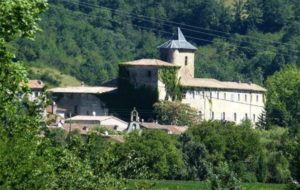
Instead of heading up to Carcassonne, Narbonne, or the coast from Mirepoix, a very interesting itinerary suggestion would be to head across to one of the prettiest villages in the region, Camon, nicknamed ‘Little Carcassonne’. This small, fortified village nestles round an ancient Benedictine abbey, whose origins date back to 923. However, the original abbey and the village were destroyed, along with Mirepoix, in 1289 when a natural dam collapsed.
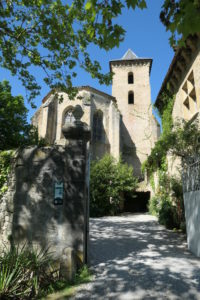
The village was rebuilt in the 14th century during the Hundred Years War in the style of a royal fortress. As a result, there are number of very attractive buildings such as the Porte de l’Horloge (Clock Gate), the Round Tower, ramparts of the Maison Haute (Tall House), as well as an abbey-château, a 16th century church and treasure house. Interesting to note that the former abbey is now privately owned and has been turned into a very upmarket Chambre d’Hotes (B&B).
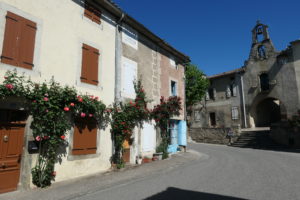
However, one of the main claims to fame for Camon is that it is known as the “village of 100 rosebushes”. Every May, Camon is in bloom with a stunning display of roses everywhere you look. This magnificent sight is at its best during the annual rose festival held on the third Sunday in May.

There is a themed walking trail in the surrounding hills that guides walkers on a tour of numerous dry-stone huts—a wonderful example of Camon’s rural heritage and wine-growing history.
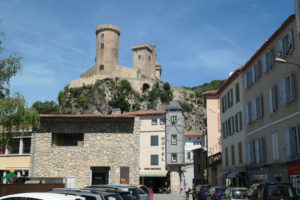
About 45 kms across to the west of Camon is the delightful small town of Foix, now the Prefecture of the Ariège department of the Occitanie region. On a rocky hill, the very impressive Chateau de Foix, whose origins date back to the early tenth century, looms large over the town—it’s easy to understand why the Romans first built a fort on this site. Charlemagne was also attracted to the location and founded an Oratory here which later became the Abbey of Saint Volusianus in 849, around which the town grew over the ensuing centuries.

The town has had a turbulent history, including having been attacked by Simon de Montfort from 1211 for about 7 years during the Albigensian Crusade. Over the ensuing centuries there were various other would-be invaders, exacerbated by Reformation conversions which saw the fortress-chateau and the abbey destroyed. Ultimately, the town was retaken by the Catholics, and in 1589 the Count of Foix, Henri de Navarre, became King Henri IV of France.
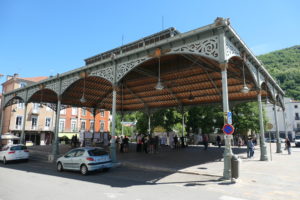
Today, the town’s sunny, cheerful streets are lined with pretty shops, lively cafes, thriving businesses, as well as two very popular markets that are held every week in the town. The Tuesday market is a food market for local producers while the Friday market includes local food, artisan crafts and products. A steep walk, or drive, up to the ruined chateau will reward with panoramic views over the town and surrounding countryside.
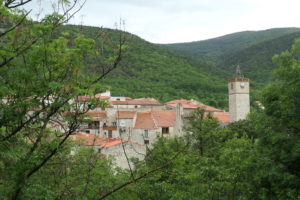
A two and a half hour drive from Foix and situated high on a hill is the small village of Mosset, another Plus Beaux Village, located in the canton of Les Pyrénées catalanes, although it’s still in France. The village originally developed around a 12th century château—now divided into private residences—whose purpose was to help defend the border between France and Aragon, hence its location at the top of a rocky promontory.
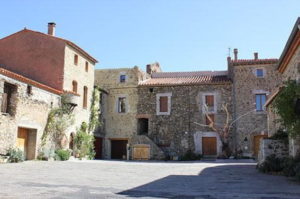
Needless to say, the views from this hilltop village across the surrounding countryside are stunning, but as well, there are the narrow medieval streets, a 17th century church, a small 13th century Romanesque chapel, as well as a 13th century watchtower, called the Mascarda Tower, which once kept watch over the valley below. A number of the village houses have round structures bulging out of their upper stories. These are bread ovens, and this unique style is said to be found only in this region of France.
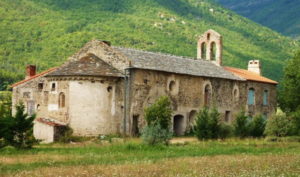
The surrounding countryside is now part of a nature reserve, and there are many marked walking tracks to follow, providing opportunities to see unusual wildflowers and if you’re lucky, perhaps a glimpse of some local wildlife scurrying away.
Eighteen kms south of Mosset is Villefranche-de-Conflent in the foothills of the eastern Pyrenees and situated at the confluence of three rivers. The original town dates from 1098, and today it’s one of the most dramatic-looking villages in the region. During its history it changed hands a number of times between French and Spanish occupation, all of whom left their mark. Consequently, it’s easy to see why it’s designated as another one of the Plus Beaux Villages de France.
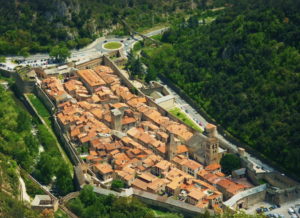
Villefranche-de-Conflent is also on the World Heritage list of 14 fortress sites by Vauban, France’s famous 17th century military engineer. Many of the village’s buildings are listed historic monuments, including the belfry tower of the Hôtel de Ville, the Church of Saint Jacques with its beautiful 12th century carved pink marble entrance, as well as the St. Pierre bridge over the river Têt.
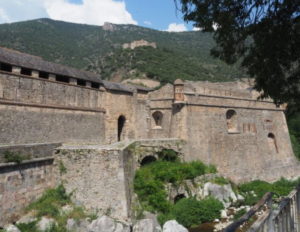
The massive, thick ramparts were adapted by Vauban to withstand the siege warfare favoured at the time. The walls still surround the entire village, and it’s possible to walk along the top of them. There are still just a few entrance doorways piercing these walls enabling access into the town. Some of the original eight towers, such as the Tour de la Viguerie, still exist. Two neo-classical monumental gateways were added at either end of the town during the 18th century.
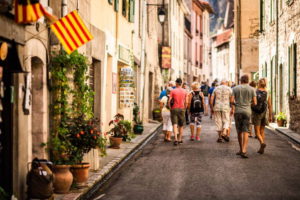
Taking a stroll along the picturesque streets, especially rue Saint-Jean, lined with cafes, art galleries, artisan craft shops and souvenir shops, you’ll see a number of little iron signs hanging outside many of them depicting the nature of the business, such as a bread-maker outside a boulangerie, a shoemaker at work or a woodturning workshop.
These are but a small sample of the unique sights that await the visitor in this beautiful but often neglected part of the country before perhaps heading to the coast, or across the border into Spain.
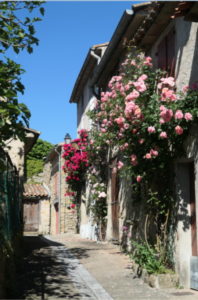


Leave a Reply